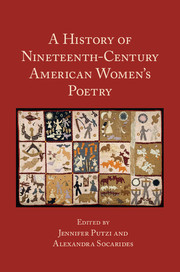Book contents
- Frontmatter
- Contents
- List of Illustrations
- List of Contributors
- Acknowledgments
- Introduction: Making History: Thinking about Nineteenth-Century American Women's Poetry
- PART I 1800–1840, AMERICAN POESIS AND THE NATIONAL IMAGINARY
- PART II 1840–1865, UNIONS AND DISUNIONS
- 8 Women, Transcendentalism, and The Dial: Poetry and Poetics
- 9 Poets of the Loom, Spinners of Verse: Working-Class Women's Poetry and The Lowell Offering
- 10 Women's Transatlantic Poetic Network
- 11 Making and Unmaking a Canon: American Women's Poetry and the Nineteenth-Century Anthology
- 12 “What witty sally”: Phoebe Cary's Poetics of Parody
- 13 Nineteenth-Century American Women's Poetry of Slavery and Abolition
- 14 Fever-Dreams: Antebellum Southern Women Poets and the Gothic
- 15 The Civil War Language of Flowers
- 16 Poetry and Bohemianism
- PART III 1865–1900, EXPERIMENT AND EXPANSION
- Suggested Further Reading
- Index
11 - Making and Unmaking a Canon: American Women's Poetry and the Nineteenth-Century Anthology
from PART II - 1840–1865, UNIONS AND DISUNIONS
Published online by Cambridge University Press: 21 January 2017
- Frontmatter
- Contents
- List of Illustrations
- List of Contributors
- Acknowledgments
- Introduction: Making History: Thinking about Nineteenth-Century American Women's Poetry
- PART I 1800–1840, AMERICAN POESIS AND THE NATIONAL IMAGINARY
- PART II 1840–1865, UNIONS AND DISUNIONS
- 8 Women, Transcendentalism, and The Dial: Poetry and Poetics
- 9 Poets of the Loom, Spinners of Verse: Working-Class Women's Poetry and The Lowell Offering
- 10 Women's Transatlantic Poetic Network
- 11 Making and Unmaking a Canon: American Women's Poetry and the Nineteenth-Century Anthology
- 12 “What witty sally”: Phoebe Cary's Poetics of Parody
- 13 Nineteenth-Century American Women's Poetry of Slavery and Abolition
- 14 Fever-Dreams: Antebellum Southern Women Poets and the Gothic
- 15 The Civil War Language of Flowers
- 16 Poetry and Bohemianism
- PART III 1865–1900, EXPERIMENT AND EXPANSION
- Suggested Further Reading
- Index
Summary
At the end of the 1840s, American poetry – and American poetry by women in particular – was collected, packaged, and marketed to a wide readership in a way that it never had been before. Three anthologies of American women's verse hit the literary marketplace at the close of the decade: Caroline May's The American Female Poets in 1848, followed in early 1849 by Rufus Griswold's The Female Poets of America and Thomas Buchanan Read's The Female Poets of America. This situation invites certain questions: Why three big books of the same nature at the same time? What was the purpose of these endeavors? How did these books position the qualities and roles of women's poetry at mid-century? What effect did the publication of these anthologies have on the field of American women's poetry, then and now?
While answers to these questions will undoubtedly shed light on issues of American women's historical poetics and how that poetics was (and continues to be) read, I want to remind readers at the outset of the fundamental concern at the heart of this story: the production of books whose contents were meant to be read did not ultimately result in such reading, at least not in the long run. Subsequent editions of each of these anthologies appeared every few years up through the 1860s – proof that there was a steady contemporary readership and demand for them – yet not one of the 123 women poets showcased in these anthologies are read by general readers today, and only a handful have found their way into university classrooms and critical discussions of literary history. In this way, this is not simply a story about a watershed moment in the history of women's poetry – its unprecedented production, circulation, and reception – that now feels far away from us in the twenty-first century; it is also about how these anthologies themselves have long positioned these poets both everywhere and nowhere. A close look at these books shows just how vexed the placement of the woman poet in literary culture was, as each editor grappled with questions about women poets’ visibility and invisibility, about their privacy and publicity.
- Type
- Chapter
- Information
- A History of Nineteenth-Century American Women's Poetry , pp. 186 - 202Publisher: Cambridge University PressPrint publication year: 2016



